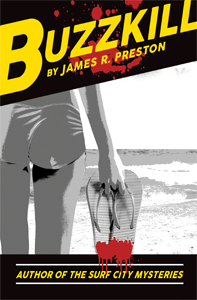
Buzzkill
“Am I going to die?”
It’s 1968. Barry Mcguire’s “Eve of Destruction” is three years old and still getting airplay.
“Mrs. Robinson” knocks “Tighten Up” (Archie Dell and the Drells) out of Billboard’s Number 1 spot. And somebody scrawls, “Stand close. It’s shorter than you think,” on the wall of a Cal State Long Beach Men’s Room. It’s a year that is both horrific and happy.
When she asks that question, Mary Jane Bailey is an eighteen-year-old college student lying on her back in a eld adjacent to Cal State Long Beach. She’s bleeding from a cut on her forehead, and a man in a sharkskin suit is standing over her holding a straight razor.
Jane is a snitch. A federal agency has asked her to keep her eyes open and report potentially violent student activities. For reasons she herself doesn’t understand, she agrees. Buzzkill, the second of Preston’s novellas set in the turbulent sixties, is the story of Jane as she tries to in ltrate a radical group and establish whether or not they’re as dangerous as they seem.
Go with Jane as she tries to follow a car (harder than it looks), to a beach party, and to a massive anti-war demonstration. Sex, drugs, and rock and roll are back. Welcome to Buzzkill.
And the man in the suit with the razor says, “Yes.”
A college student’s work as a confidential informant puts her dangerously close to a radical group with sinister plans in this novel.
Mary Jane Bailey’s freshman year at Cal State Long Beach in 1968 doesn’t involve the typical campus activities one might expect. Not long after her registration, a federal agency asks her to be an informant in order to infiltrate a group known as Burn It Down. Shortly thereafter, she witnesses masked individuals attack one of her handlers, Terry Griswald, a local detective. Jane furthermore encounters enigmatic Thaddeus Blank, who indirectly threatens her by brandishing a straight razor in plain sight and demands details on any BID reports she gives to the cops. Jane has a way into BID with classmate Maggie Molyneaux, who soon introduces her to Junior Higgins, the apparent leader. Including other female members, the BID “family” appears to be a batch of harmless, peace-loving hippies. But it’s evident that Junior is concocting something devious which involves Jane, whether she’s a willing participant or not. With help from Terry and fellow student Rider, Jane tries to decipher what exactly Junior’s ultimate objective is while dodging—or outright confronting—the occasional assailant. Preston’s (Crashpad, 2017, etc.) story is a fairly straightforward mystery; villains are generally pronounced, and even Junior’s scheme isn’t surprising. But the characters are a lively, extraordinary assortment. Jane, for starters, is a remarkable protagonist, unfazed by facing multiple baddies with a two-by-four or just her purse. Others stand out via their discernible shortcomings: Blank is shaken by Jane’s lack of intimidation when he sports his straight razor, and unassertive Terry wonders whether she set him up for the attack. The story thoroughly embodies the ’60s era, both its anti-war sentiments and pop culture. The decade is also humorously portrayed through Blank’s largely failed attempts at using slang; at one point, he confuses Jane by referencing already-outmoded “sock hops.”
A historical thriller enriched by characters who sparkle and refuse to be forgotten.
Amazon - Paperback / Kindle B&N - Paperback / Nook Apple- iBooks